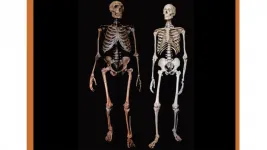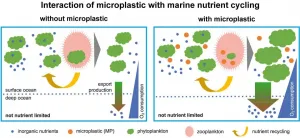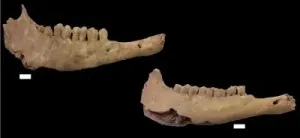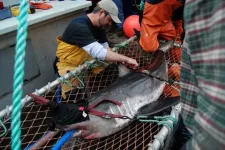(Press-News.org) Creativity--the "secret weapon" of Homo sapiens--constituted a major advantage over Neanderthals and played an important role in the survival of the human species. This is the finding of an international team of scientists, led by the University of Granada (UGR), which has identified for the first time a series of 267 genes linked to creativity that differentiate Homo sapiens from Neanderthals.
This important scientific finding, published today in the prestigious journal Molecular Psychiatry (Nature), suggests that it was these genetic differences linked to creativity that enabled Homo sapiens to eventually replace Neanderthals. It was creativity that gave Homo sapiens the edge, above and beyond the purely cognitive level, by facilitating superior adaptation to the environment compared to that of now-extinct hominids and providing greater resilience to ageing, injury, and disease.
The research team comprises Igor Zwir, Coral del Val, Rocío Romero, Javier Arnedo, and Alberto Mesa from the UGR's Department of Computer Science and Artificial Intelligence, the Andalusian Research Institute in Data Science and Computational Intelligence (DaSCI), and the Biohealth Research Institute in Granada (ibs.GRANADA), together with Robert Cloninger of Washington University in St. Louis and colleagues from the Young Finns Study (Finland), the American Museum of Natural History (New York), and the Menninger Clinic (Houston, Texas).
Their findings are the result of an interdisciplinary study that brings together Artificial Intelligence (AI), Molecular Genetics, Neurosciences, Psychology, and Anthropology. This is the fifth consecutive paper published by this research team in one of the most prestigious scientific journals in the area concerned with the human personality.
The 267 genes identified by these scientists as being unique to Homo sapiens are part of a larger group of 972 that are linked to personality in healthy adults and were also discovered by the same authors. In previous studies, they showed that these 972 genes are organized into three dissociable brain networks of personality traits that are responsible for learning and memory.
Evolution of genetic networks
"These networks evolved in stages. The most primitive network emerged among monkeys and apes about 40 million years ago, and is responsible for emotional reactivity--in other words, it regulates impulses, the learning of habits, social attachment, and conflict-resolution," explain the UGR researchers. Less than 2 million years ago, the second network emerged. This regulates intentional self-control: self-direction and social cooperation for mutual benefit. Finally, about 100,000 years ago, the network relating to creative self-awareness emerged.
The new study that is published this week reveals that the genes of the oldest network, that of emotional reactivity, were almost identical in Homo sapiens, Neanderthals, and chimpanzees. By contrast, the genes linked to self-control and self-awareness among Neanderthals were "halfway between" those of chimpanzees and Homo sapiens.
Most of these 267 genes that distinguish modern humans from Neanderthals and chimpanzees are RNA regulatory genes and not protein-coding genes. Almost all of the latter are the same across all three species, and this research shows that what distinguishes them is the regulation of expression of their proteins by genes found exclusively in humans. Using genetic markers, gene-expression data, and integrated brain magnetic resonance imaging based on AI techniques, the scientists were able to identify the regions of the brain in which those genes (and those with which they interacted) were overexpressed. These regions are involved in human self-awareness and creativity, and include the regions that are strongly associated with human well-being and that appeared relatively recently, phylogenetically speaking.
Superior resilience
Furthermore, the authors continue, "thanks to these genes, Homo sapiens enjoyed greater physical fitness than now-extinct hominids, providing them with a superior level of resilience to ageing, injury, and disease." Using genetic data, the researchers were able to estimate from these genes that the adaptability and well-being of Neanderthals were approximately 60%-70% those of Homo sapiens, meaning that the difference between them in terms of physical fitness was significant.
The findings have far-reaching implications in our understanding of the factors that ultimately enabled Homo sapiens to replace Neanderthals and other species in the geologically-recent past. The authors hypothesize that creativity may have given Homo sapiens selective advantages beyond the purely cognitive realm.
"Living longer and healthier lives may have prolonged the period of learning associated with youth and adolescence, which would facilitate the accumulation of knowledge. This is a remarkable characteristic of behaviourally-modern humans and an important factor in economic and social success," explain the researchers. Creativity may have encouraged cooperation between individuals in a bid to encourage success among their descendants and their community. This would have set the stage for technological innovation, behavioural flexibility, and openness to exploration, all of which were necessary for Homo sapiens to spread across the world more successfully than other human lineages.
In the five studies published to date by these researchers in Nature, they have found--and verified using multiple data sources--that human behaviour is neither entirely fixed nor solely determined by our genes, but rather is influenced also by multiple interactions with the environment. "We have the capacity to learn and adapt in light of our experience, even to the extent of modifying the expression of our genes. Human creativity, prosociality, and healthy longevity emerged as a response to the need to adapt to the harsh and diverse conditions that reigned between 400,000 and 100,000 years ago," note the UGR researchers.
This study is just one example of how the use of AI techniques and the entirely bias-free treatment of data can help to solve many puzzles about the evolution of human beings. The results obtained pave the way to the development of new lines of research that can ultimately promote human well-being and help us to adapt creatively in order to overcome critical situations.
INFORMATION:
Children with weakened immune systems have not shown a higher risk of developing severe COVID-19 infection despite commonly displaying symptoms, a new study suggests.
During a 16-week period which covered the first wave of the pandemic, researchers from Southampton carried out an observational study of nearly 1500 immunocompromised children - defined as requiring annual influenza vaccinations due to underlying conditions or medication. The children, their parents or guardians completed weekly questionnaires to provide information about any symptoms they had experienced, COVID-19 test results and the impact of the pandemic on their daily life.
The results, published in BMJ Open, showed that symptoms of COVID-19 infection were common in many of the children - with ...
The effects of the steadily increasing amount of plastic in the ocean are complex and not yet fully understood. Scientists at GEOMAR Helmholtz Centre for Ocean Research Kiel have now shown for the first time that the uptake of microplastics by zooplankton can have significant effects on the marine ecosystem even at low concentrations. The study, published in the international journal Nature Communications, further indicates that the resulting changes may be responsible for a loss of oxygen in the ocean beyond that caused by global warming.
Plastic debris in the ocean is a widely known problem for large marine mammals, fish and seabirds. These ...
The results, exceptional first time evidence of how early flocks of domesticated sheep fed and reproduced within the Iberian Peninsula, are currently the first example of the modification of sheep's seasonal reproductive rhythms with the aim of adapting them to human needs.
The project includes technical approaches based on stable isotope analysis and dental microwear of animal remains from more than 7,500 years ago found in the Neolithic Chaves cave site in Huesca, in the central Pyrennean region of Spain. The research was coordinated from the Arqueozoology Laboratory of the UAB Department of Antiquity, with the participation of researchers from the University of Zaragoza, the Museum of Natural History of Paris, and the Catalan Institute of Human Palaeocology and Social Evolution (IPHES) ...
Most battery materials, novel catalysts, and storage materials for hydrogen have one thing in common: they have a structure comprised of tiny pores in the nanometer range. These pores provide space which can be occupied by guest atoms, ions, and molecules. As a consequence, the properties of the guest and the host can change dramatically. Understanding the processes inside the pores is crucial to develop innovative energy technologies.
Observing the filling process
So far, it has only been possible to characterise the pore structure of the substrate materials precisely. The exact structure of the adsorbate inside the pores has remained hidden. To probe this, a team from the HZB together with colleagues ...
The natural menopause occurs when the menstrual periods cease due to the naturally decreased ovary function. There is a significant interindividual variation in the age at natural menopause but, on average, women undergo it around the age of 51 in Western countries. Furthermore, the length of the preceding menopausal transition, characterized by irregular menstrual cycles and menopausal symptoms, is also known to vary between individuals.
The study revealed that higher estradiol and follicle-stimulating hormone levels, irregular menstrual cycles, and menopausal symptoms are strong indicators of approaching menopause in middle-aged women. Additionally, information related ...
DALLAS - April 21, 2021 - Food banks should be used more consistently rather than only during emergencies to better address food insecurity and related health issues, a joint study by researchers at UT Southwestern Medical Center and economists at the University of Dallas shows.
"The main discovery in our research is that encouraging clients and making it easier for clients to receive food frequently improves their food security, health, and well-being," says Sandi Pruitt, Ph.D., associate professor of population and data sciences at UT Southwestern, and senior author of the ...
Perhaps no other ocean creature lives in the human imagination like the great white shark. But while great white sharks might be plentiful in the minds of beachgoers across the country, there are only a handful of places in the world where white sharks can be consistently found. In those areas -- such as Central California, Guadalupe Island Mexico, South Australia and South Africa -- they tend to be found aggregated in small hotspots, often located around seal colonies.
Researchers have estimated that white shark populations are incredibly small, with only hundreds of large adults and a few thousand white sharks total in any of their global ...
UNIVERSITY PARK, Pa. -- A new approach to gene editing using the CRISPR/Cas9 system bypasses disease-causing mutations in a gene, enabling treatment of genetic diseases linked to a single gene, such as cystic fibrosis, certain types of sickle cell anemia, and other rare diseases. The method, developed and tested in mice and human tissue cultures by researchers at Penn State, involves inserting a new, fully functional copy of the gene that displaces the mutated gene.
A proof-of-concept for the approach is described in a paper appearing online April 20 in the journal Molecular Therapy.
The CRISPR/Cas9 system has allowed promising new gene therapies ...
The number of solar panels within shortest distance from a house is the most important factor in determining the likelihood of that house having a solar panel, when compared with a host of socio-economic and demographic variables. This is shown in a new study by scientists using satellite and census data of the city of Fresno in the US, and employing machine learning. Although it is known that peer effects are relevant for sustainable energy choices, very high-resolution data combined with artificial intelligence techniques were necessary to single out the paramount importance of proximity. The finding is relevant for policies that aim at a broad deployment of solar panels in order to replace unsustainable ...
The lifestyle and eating habits of human groups that have lived for thousands of years can be examined by tooth. An international research group analyzed the prehistoric findings of the Neolithic Age. In addition to providing knowledge about the lifestyles of people who lived in prehistoric times, a novel study of tooth remains paved the way for other methods previously not used. This study applies the complementary approaches of stable isotope and dental microwear analyses to study the diets of past people living in today's Hungary. Their joint results were published in the scientific journal Scientific Reports.
The Great Hungarian Plain is considered one of the most interesting areas for archeology because ...







